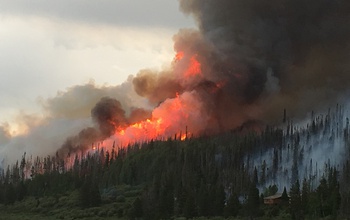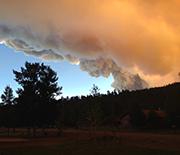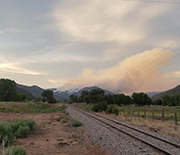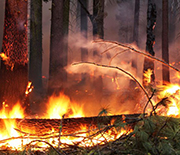News Release 18-054
Scientists fly above wildfires this summer to clarify chemistry of smoke
Largest, most comprehensive attempt to date to measure and analyze wildfire smoke

Smoke billows from the Beaver Creek Fire west of Walden, Colorado, in 2016.
July 19, 2018
This material is available primarily for archival purposes. Telephone numbers or other contact information may be out of date; please see current contact information at media contacts.
Find related stories on NSF's geosciences risk and resilience interest area.
On August 11, 2018, the WE-CAN team will host a research aircraft media event at the Boise Airport, featuring two aircraft: the NSF/NCAR C-130 and the University of Wyoming King Air.
This summer, a four-engine cargo plane laden with scientists and sophisticated equipment will make flights straight into hazy smoke from Western wildfires.
The flights will be the largest, most comprehensive attempt to date to measure and analyze the wildfire smoke that blankets vast swaths of the U.S. every year.
From late July through August, a team of scientists will travel to Boise, Idaho, to conduct 15 to 20 smoke observation flights. The project is called the Western Wildfire Experiment for Cloud Chemistry, Aerosol Absorption and Nitrogen, or WE-CAN, and is supported by the National Science Foundation (NSF).
"These researchers are following the transport and transformation of the plume of gases and aerosols emitted by wildfires to understand the chemical changes they undergo over time, how their properties might vary, and their impacts on human health and the environment," said Sylvia Edgerton, a program director in NSF's Division of Atmospheric and Geospace Sciences, which funds WE-CAN.
The project brings together scientists from five universities and the NSF-funded National Center for Atmospheric Research.
"This is a challenging field campaign," said atmospheric scientist Emily Fischer of Colorado State University (CSU). "It's not like measuring the plume from, say, a power plant. We don't know exactly where the fires will be, but we know that pretty much every year, there is a wildfire burning within a two-hour flight of Boise during the month of August."
The researchers will attempt to answer such questions as: What is the smoke made of? How does it change over time, and as it travels? How does it affect clouds? How does the type and growth of the forest affect the composition of smoke produced? How does the smoke chemistry of hot-burning fires compare to that of lower-temperature, smoldering fires?
Answering these and other questions has major ramifications for studies of air quality, health, nutrient cycles, weather and climate. The WE-CAN researchers hope to contribute to science in all these areas with the data they'll collect this summer.
Their goal is a comprehensive, systematic understanding of the chemistry of wildfire smoke, focused on three main issues related to wildfire smoke: increasing the understanding of the amount and types of reactive nitrogen in smoke plumes; quantifying and understanding emissions and the evolution of fine particulate matter and optical properties of smoke; and identifying how smoke plume particles affect the behavior and formation of liquid and ice clouds.
The diverse backgrounds of the team reflect the scope of the scientific questions they will explore. Fischer's expertise is in reactive nitrogen and ozone; her group will take the lead on measurement of atmospheric ammonia. Shane Murphy of the University of Wyoming (UW) will head the investigation into absorbing aerosols. Other scientists from CSU, including Paul DeMott and Amy Sullivan, will explore smoke particles and their effects on clouds.
The WE-CAN campaign goes above and beyond other wildfire air-quality experiments conducted in the past, said Fischer. She explained that previous atmospheric science field campaigns have touched on wildfire smoke, but that has not been their main focus.
"What we are doing in WE-CAN is much more systematic," Fischer said. "We will start as close as we can to the fires and track the smoke for 12 to 24 hours. That's when a lot of the chemical evolution happens. We have very few existing samples of this evolution in the atmosphere."
The plane being used is NSF's C-130 research aircraft, which makes its home in Broomfield, Colorado, at Rocky Mountain Metropolitan Airport.
The aircraft will carry some 30 scientific instruments and has room for 18 scientists. Many other researchers will be on the ground, monitoring fires, smoke and weather to guide the plane to prime data-collecting zones.
The teams will conduct six-hour flights, multiple times over six to eight weeks.
After the field campaign wraps up, Fischer and others will teach a two-week aircraft observations class in early September for students from several universities, including CSU, UW, North Carolina Agricultural and Technical State University, and the University of Montana. The students will learn about aircraft-based atmospheric science, and discover where to fly a plane, and when.
The project is also supported in part by NOAA and NASA.
-NSF-
-
NSF's C-130 aircraft is instrumental in the project to study wildfire smoke.
Credit and Larger Version -
Scientists prepare WE-CAN project instrumentation to load aboard the NSF C-130 aircraft.
Credit and Larger Version -
The 2013 West Fork Fire in Colorado. WE-CAN scientists will track similar fires this summer.
Credit and Larger Version -
Smoke from the June 2018 "416" wildfire in Durango, Colorado, blankets the area.
Credit and Larger Version -
Wildfire burns through a forest. WE-CAN researchers will look at tree types in the project.
Credit and Larger Version
Media Contacts
Cheryl Dybas, NSF, (703) 292-7734, email: cdybas@nsf.gov
Anne Manning, CSU, (970) 491-7099, email: anne.manning@colostate.edu
The U.S. National Science Foundation propels the nation forward by advancing fundamental research in all fields of science and engineering. NSF supports research and people by providing facilities, instruments and funding to support their ingenuity and sustain the U.S. as a global leader in research and innovation. With a fiscal year 2023 budget of $9.5 billion, NSF funds reach all 50 states through grants to nearly 2,000 colleges, universities and institutions. Each year, NSF receives more than 40,000 competitive proposals and makes about 11,000 new awards. Those awards include support for cooperative research with industry, Arctic and Antarctic research and operations, and U.S. participation in international scientific efforts.
Connect with us online
NSF website: nsf.gov
NSF News: nsf.gov/news
For News Media: nsf.gov/news/newsroom
Statistics: nsf.gov/statistics/
Awards database: nsf.gov/awardsearch/
Follow us on social
Twitter: twitter.com/NSF
Facebook: facebook.com/US.NSF
Instagram: instagram.com/nsfgov







